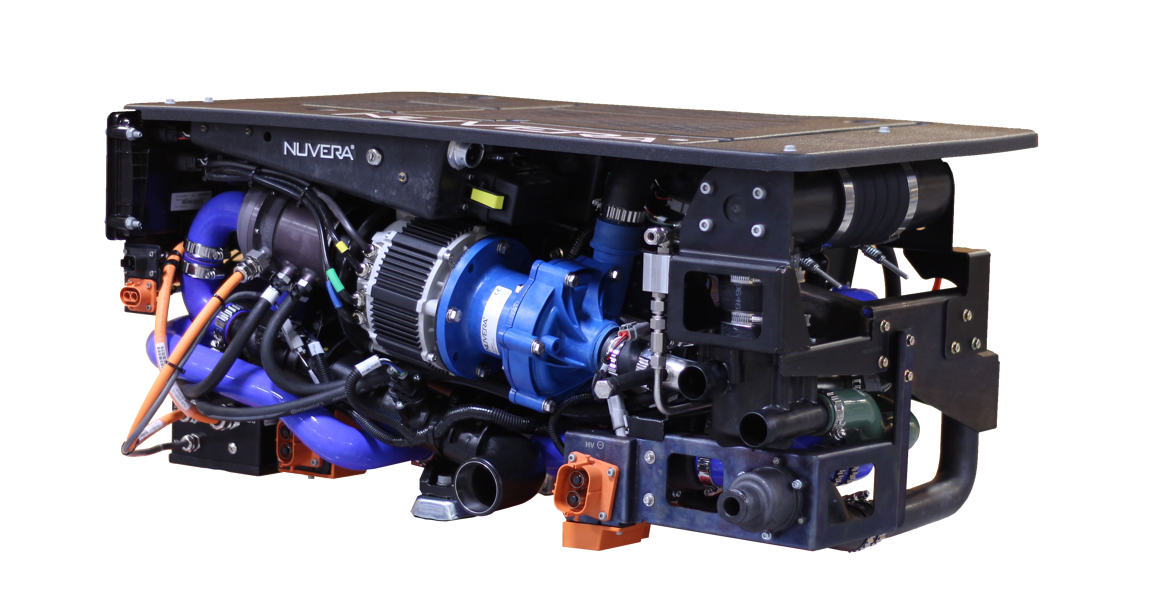Massachusetts-based fuel cell solutions provider Nuvera Fuel Cells has received a purchase order and signed a memorandum of understanding with Norwegian engineering firm Hytech, which will evaluate the use of the fuel cell engines for stationary power uses. The two companies also aims to deploy hydrogen-powered hydraulic pumps, auxiliary power units, and mobility solutions. “With our team based in Milan, Italy, and remote support from our US headquarters, Nuvera is poised to serve customers in Europe with fuel cell engines to expand the deployment of high-performance zero-emission vehicles,” the American company wrote earlier this month. Nuvera fuel cell engines are claimed to provide world-class performance for motive platforms in outputs ranging from 5 to 120 kW and higher. The engines are available in two modules, the Nuvera E-45 and E-60 Fuel Cell Engines, which the manufacturer said can power mid- and heavy-duty vehicles such as buses, trucks, port equipment and delivery vans. For high-power applications, multiple engines can be combined.
European aerospace company Airbus and Japan's Kawasaki Heavy Industries have signed a memorandum of understanding to jointly develop a hydrogen-fueled ecosystem. “The scope will include different aspects of the hydrogen supply chain, from the production of hydrogen to its delivery to airports and transfer on-board aircraft,” Airbus wrote on Tuesday.
Wind power specialist Storgrundet Offshore and green hydrogen provider Lhyfe entered into a memorandum of understanding to jointly build a 600 MW hydrogen production plant in Sweden. “The plant is to be built from 2025 onwards in several project phases and will be one of the largest hydrogen production facilities in Europe,” Lhyfe stated, explaining that the production plant will be built in the vicinity of the offshore Storgrundet wind farm, in the industrial area of Söderhamm. The installed capacity of the wind farm is to be expanded to 1 GW in the future. On Tuesday, Lhyfe announced it raised €10 million from Japanese trading and investment conglomerate Mitsui.
Three researchers from Tel Aviv University, and two from the University of Münster presented a strain of microalgae defective in thylakoid proton gradient regulation, whose “unique physiology supports the simplistic, yet robust and scalable, hydrogen production capability.” Microalgae, biocatalysts of hydrogen production, normally require an oxygen-free environment. Normally, the algal hydrogen production is not scalable because it is short-lived due to electron loss to other processes, mainly carbon fixation, the researchers wrote. “Here, we show that a strain defective in thylakoid proton gradient regulation, Δpgr5, bypasses both challenges simultaneously, leading to a prolonged 12-day hydrogen production under ambient mixotrophic conditions in a 1-L setup,” reads an article published in Cell Reports Physical Science. The scientists wrote that Δpgr5 possess a repressed ability to fixate carbon and “that this limitation is counterbalanced by an enhanced chloroplast-mitochondrion energetic exchange.”
Five researchers from South Korea applied a contingent valuation method to examine how much consumers are willing to pay for green hydrogen charging compared to gray hydrogen charging. They found that the monthly mean of willingness to pay per driver is KRW 51,674 ($45.85), equivalent to KRW 4,302 per kg. “Additionally, consumers accept a 28.5% increase in the monthly average fuel expenses when converting to green hydrogen,” the researchers wrote in the International Journal of Hydrogen Energy. They added that the findings could guide the development of pricing and energy use plans to finance the expansion of green hydrogen infrastructure.
India's renewable energy company Greenko Group, via its subsidiary Greenko ZeroC (GZC), and Belgian mechanical engineering group John Cockerill signed an exclusive agreement to jointly manufacture alkaline electrolyzers in the Indian sub-continent within the next few years. The two companies “will build a hydrogen electrolyzer gigafactory targeting capacity of 2 gigawatts which will substitute 8% of India LNG imports,” the companies wrote on Monday. The gigafactory, which will comprise the full manufacturing electrolyzer value chain, including nickel coating, will produce electrolyzers delivering H2 at 30 bars at the outlet. Last month, the two companies signed a related framework agreement, explaining that the hydrogen would serve the local market. According to Indian reports, the two companies will set up a 50-50 joint venture; the factory could be ready within 18 months. In March, the Indian company signed a memorandum of understanding with Paris-based engineering company Technip Energies to explore green hydrogen development opportunities across industries.
Australia-based Aqua Aerem, the proponent of the 10 GW Desert Bloom Hydrogen project, and Japan's Osaka Gas have entered into a joint development agreement. Desert Bloom Hydrogen would produce renewable hydrogen for domestic and export markets using only off-grid renewable energy. Details of the agreement are confidential, but Osaka Gas will coordinate and help Aqua Aerem in three main fields: project management, hydrogen sales and equipment sourcing. The project consists of a series of modular 2 MW hydrogen production units capable of generating water from the atmosphere, as well as producing heat, renewable electricity, and green hydrogen. The venture, which aims to produce green hydrogen at less than $2/kg within five years, is backed by Sanguine Impact Investment. Sanguine wants to increase the scale of the project to 20 GW.
Countries, especially potential exporters, should improve hydrogen statistics to justify and promote investments in hydrogen. The measures should result from broad cooperation, also intended to standardize and homogenize measurements, said Columbia University‘s Anne-Sophie Corbeau. “Countries could start working together to determine how best to collect hydrogen data, both on the demand and production sides, and include existing consumption as well as potential future consumption in new sectors. Statistics on the demand side need to anticipate new uses in buildings, industry, transport, and power, as well as account for hydrogen's potential use to produce other energy products such as ammonia and methanol,” the French scholar wrote on Monday.
Vancouver-based First Hydrogen has identified four industrial sites in the United Kingdom and is advancing discussions with landowners to secure land rights to develop green hydrogen production projects. It said it would be working with engineering consultants Ove Arup & Partners Limited (ARUP) for engineering studies and designs. “The sites are all in prime industrial areas spread strategically across the North and South of the United Kingdom and will each accommodate both a large refueling station — for light, medium and heavy commercial vehicles with on-site hydrogen production, to serve the urban areas of Greater Liverpool, Greater Manchester, the London area, and the Thames Estuary — and a larger hydrogen production site of between 20 and 40 MW, for a total for the four sites of between 80 MW and 160 MW,” First Hydrogen wrote on Monday. The Canadian company wants to use the production facilities to serve customers of its automotive division. “First Hydrogen's green hydrogen van is to begin demonstrator testing in June with final delivery for road use in September 2022.”
Norway-based green hydrogen provider Gen2 Energy has signed a contract with Sirius Design & Integration to design two ships meant to transport large quantities of containers with compressed hydrogen. Gen2 Energy's two container carriers are large vessels that will be about 190 meters long with a load capacity of 500 pieces and 40-foot containers, the company said. “The vessels will be designed with the aim of leaving the least possible climate footprint. Using hydrogen in the propulsion systems of the vessels will be part of the design work. The ship design work is well underway,” Gen2 Energy wrote on Monday. Gen2 Energy is developing large-scale production of hydrogen in Mosjøen, Norway, targeting northern European customers.
Germany-based energy company Uniper will test storing 100% hydrogen on a large scale and in a real environment at the former salt cavern storage facility in Krummhörn in northern Germany. The facility, which has not been used commercially since 2017, will be converted in the coming years. “For this purpose, a new cavern will be sunk using an existing well. The storage facility will be one of the first of its kind and is expected to be operational by 2024,” wrote the company, adding that it would invest €10 million in the green future project with a storage volume of up to 250,000 m3 of hydrogen. The demonstration facility is around 80 kilometers from Wilhelmshaven.
Denmark-based Green Hydrogen Systems announced technical design complications in its A-Series platform. “The complications will impact the guidance for 2022 due to further delay in delivery of the order backlog,” the company wrote on Tuesday.
Dutch natural gas infrastructure and transportation company Gasunie, Rotterdam-based bulk products company HES International (HES), and Dutch storage company Vopak have signed a head of terms to jointly develop an import terminal for green ammonia as a hydrogen carrier. “The terminal, that will operate on the Maasvlakte under the name ACE Terminal, will be operational from 2026,” wrote Gasunie on Monday.
On Tuesday, the Port of Rotterdam said that oil and gas major Shell was the first company to sign an agreement to use HyTransPortRTM. “This is the hydrogen pipeline in the port of Rotterdam that Gasunie is laying in collaboration with the Port of Rotterdam Authority from the Maasvlakte to Pernis in order to make the industry in the port more sustainable,” the Port wrote. Holland Hydrogen I, the electrolyzer that Shell plans to build at the Conversion Park on the Maasvlakte, will be connected to the pipeline. The hydrogen will be transported from the conversion park to Pernis via the HyTransPortRTM pipeline, which is expected to be in use by early 2025.
California-based solutions provider Clean Energy Enterprises (CEE) has executed a strategic cooperation agreement with Norway's capture and mineralization solution company CAPTICO2. The agreement “allows the two companies the ability to promote each partner's technology and develop markets together,” the companies wrote on Tuesday. CEE commercializes waste-to-hydrogen conversion solutions through its subsidiary Ways2H.
The British Department for Transport (DfT) awarded GBP 1.95 million in funding to 51 innovative transport proposals. “Unitrove Innovation Ltd is being backed to develop a control system for the world's first liquid hydrogen fuel container facility for zero emission ships (as seen in the image above),” the British government wrote on Wednesday.
Enel Green Power and Italy-based industrial and medical gas company Sapio signed an agreement to supply green hydrogen produced by NextHy in Sicily. “The agreement provides for the sale to Sapio of the green hydrogen that will be produced, stored and made available from 2023 at the Carlentini and Sortino production sites, home to Enel Green Power's futuristic NextHy innitiative,” Enel Green Power wrote on Wednesday. The production capacity of the facility is estimated at more than 200 tons a year. The green hydrogen will be produced mainly by a 4 MW electrolyzer powered by the existing wind farm.
Italy's Ministry of Ecological Transition has signed a program agreement with the National Agency for New Technologies, Energy and Sustainable Economic Development (ENEA) for research and development activities on hydrogen, which will be financed with resources from the National Recovery and Resilience Plan. The agreement provides for a maximum contribution of €110 million, including the amounts allocated to the external implementing bodies that ENEA uses to carry out part of the research activities.
This content is protected by copyright and may not be reused. If you want to cooperate with us and would like to reuse some of our content, please contact: editors@pv-magazine.com.


They’re not even photocatalytic hydrogen converters, but it’s nice to see this coverage. NASA still has hydrogen fill valve issues, yet it seems like industry has some ideas it’s willing to move on as if leaks and spills were a solved thing every chemistry student drills on, or hydrogen still mops were a thing.